Homemade German Bratwurst
This post may contain affiliate links. See my disclosure policy.
Experience the delicious taste of Germany through this thoroughly authentic homemade bratwurst recipe! Make a double batch, freeze them, and you can conveniently grab and grill a bratwurst any time the craving hits you!
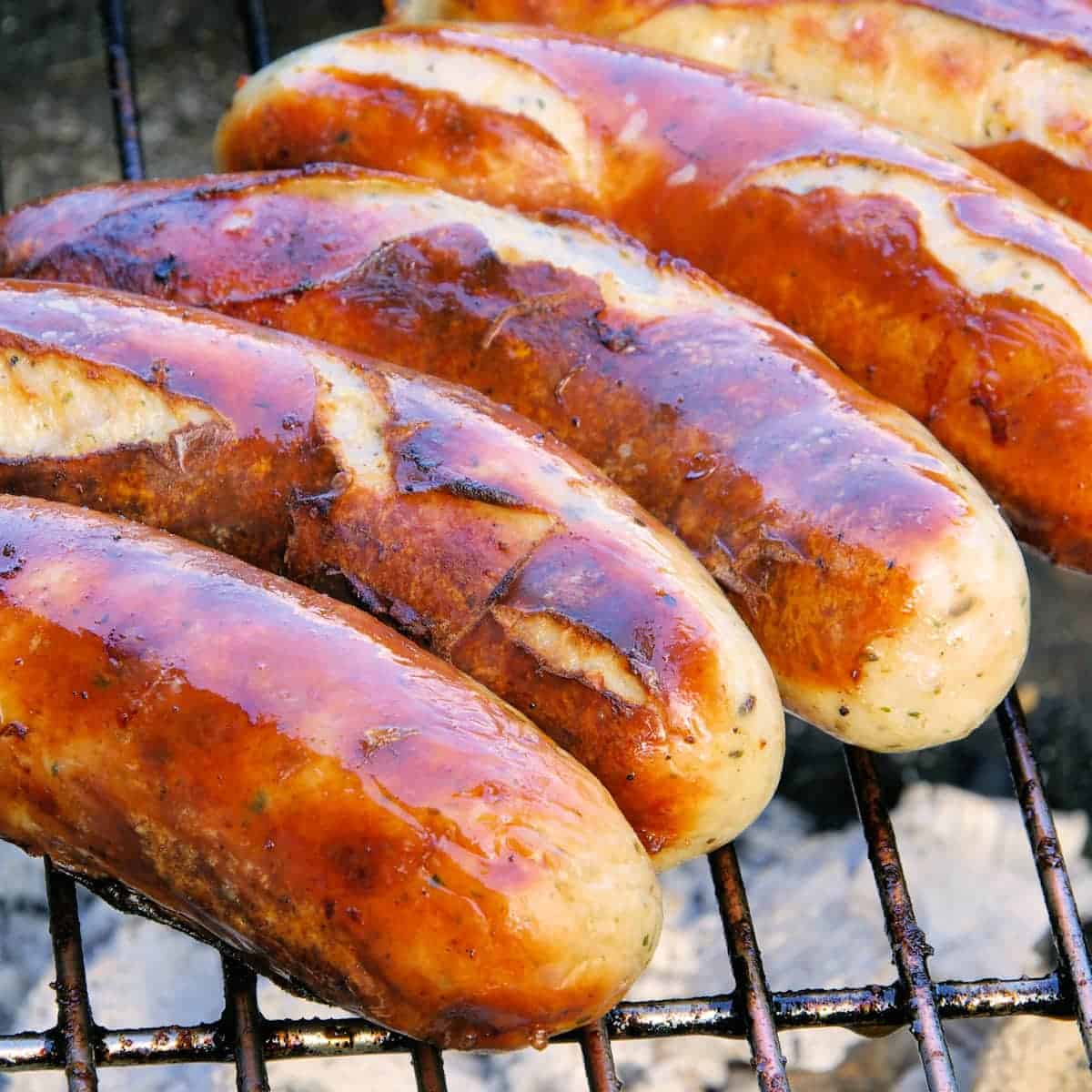
German Bratwurst
This is a special day because today is the day I’m going to show you how to make bratwurst. And not just any bratwurst. I’m going to share with you my recipe for authentic homemade German bratwurst! With the first bite you’ll immediately recognize that “German flavor” that you know and love from time spent in Germany eating Bratwurst from the German fast food stands. Whether enjoyed whole and served with mustard on a crusty roll or sliced and served as Currywurst, there is nothing quite like a real German Bratwurst!
Boasting over 1500 varieties of Wurst, Germany has long been the world’s Sausage Capital. One such Wurst, the Bratwurst, claims around 40 different varieties itself and has a proud heritage going back hundreds of years where it was first officially documented in 1313. Yes, the savory Bratwurst is synonymous with Germany itself and has remained a cultural icon for centuries.
The term Bratwurst is derived from the Old German word Brät (meaning “chopped” meat) as well as the more contemporary verb braten (meaning “to fry”). While some kinds of sausages are eaten poached, the Bratwurst is always grilled or pan-fried to get the skins nice and crispy. However, you can first poach before grilling/frying to infuse them with more flavor (like poaching them in beer) or if you simply want to ensure that they’re evenly cooked through before grilling or frying them.
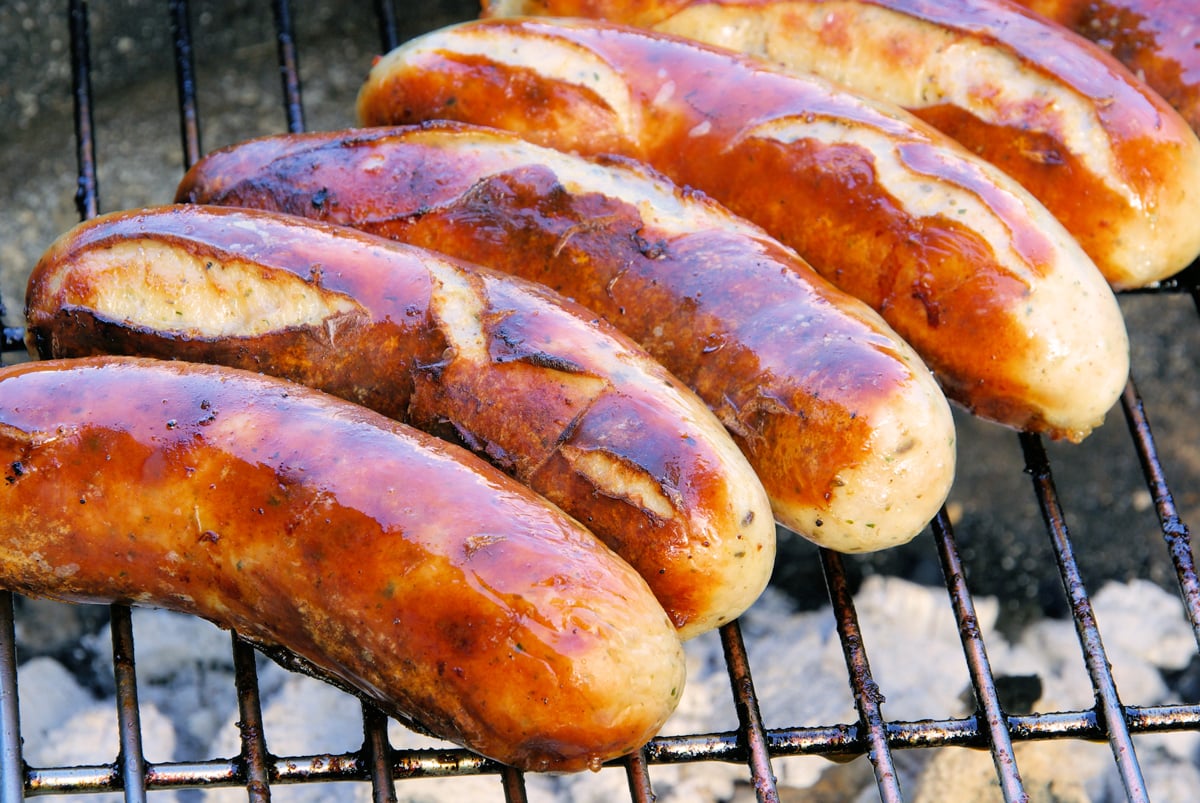
Different regions of Germany make their Bratwursts a little differently and the spices and herbs will vary as well the kind of meat used. Some varieties use pork only, some use a combination of pork and veal, some use mostly veal with a little pork, while others use pork with a little beef.
Some of the most popular regional varieties include the Fränkische Bratwurst, Nürnberger Rostbratwurst, Thüringer Bratwurst (very long and thin, my favorite as a kid) and Rote Wurst (from the Swabia region where I grew up and made with the addition of bacon, yum!).
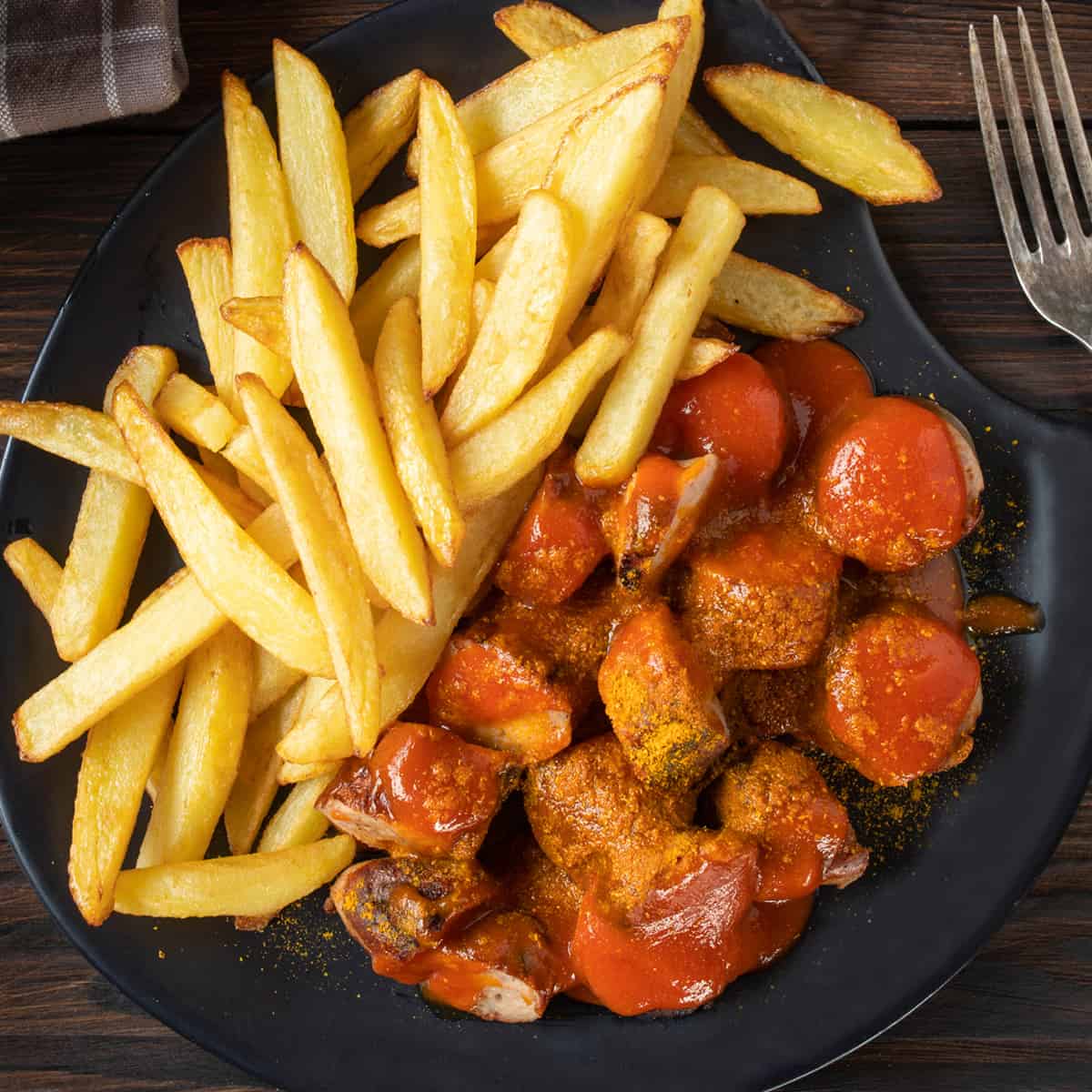
Sausage Making Equipment
For making sausages you’ll need a meat grinder and a sausage stuffer. Years ago I tried using the Kitchenaid attachments for both of these and as any experienced sausage maker will tell you, they’re downright frustrating if you want to make any more than 2 or 3 sausages. If making sausages is something you’re interested in doing I strongly recommend getting some good equipment that won’t leave you frustrated, vowing never to make sausages again, and that won’t jeopardize the quality of your sausages.
In choosing our sausage-making equipment, my husband and I did a lot of research and chose the items that were great quality without having to pay a fortune.
Meat Grinder
I use the STX International Turbo Force Electric Meat Grinder. With 3000 watts, 3 speeds and a 3-year warranty, it has high reviews and comes top recommended by most review sites as the best bang for the buck.
Sausage Stuffer
I also use the Super Deal Heavy Duty 5L Vertical Sausage Stuffer and have been very happy with it. We carefully researched the sausage stuffers on the market and chose this one specifically because of it’s large capacity and 100% metal construction (no plastic parts = not breakable) and it’s also easy to clean.
Hog Casings
I only use casings from The Sausage Maker. They are sourced from North American hogs whereas other brands source them from China. I use and recommend these hog casings from The Sausage Maker.
Sausage Making Books
Once you get the basics of sausage-making down you can experiment with your own flavors and combinations which is what I love to do. But having a few good books with sound instructions for technique and reliable recipes are a must. I have combed through many books on charcuterie and sausage-making over the past few years and these ones continue to be my favorites:
Great Sausage Recipes and Meat Curing by Kutas is a classic and one of the first comprehensive books written on the subject. It’s a no-nonsense, straight-forward book packed full of recipes. Charcuterie: The Craft of Salting, Smoking and Curing by Ruhlman has likewise been a very popular book. The current edition is revised and updated. I have the previous edition and there are inaccuracies and errors in it that the newest edition has reportedly fixed, but I still hear complaints about it. Nevertheless, it’s a great book with some great recipes. Olympia Provisions: Cured Meats and Tales from an American Charcuterie is both a fun and inspiring read. The author, Elias Cairo, is the founder of Olympia Provisions in Portland, Oregon and owns several restaurants and butcher shops there. This book features several of his most popular recipes.
The final two books are both written by Stanley & Adam Marianski: The Art of Making Fermented Sausages and Home Production of Quality Meats and Sausages. While these are a very dry read and don’t have the beautiful photography or inspirational stories the other books have, I consider these indispensable to anyone who is serious about learning the art of charcuterie and sausage-making. Consider them the most comprehensive “how-to” manuals on the market. And if you are planning on dabbling in dry-cured meats, The Art of Making Fermented Sausages is a MUST.
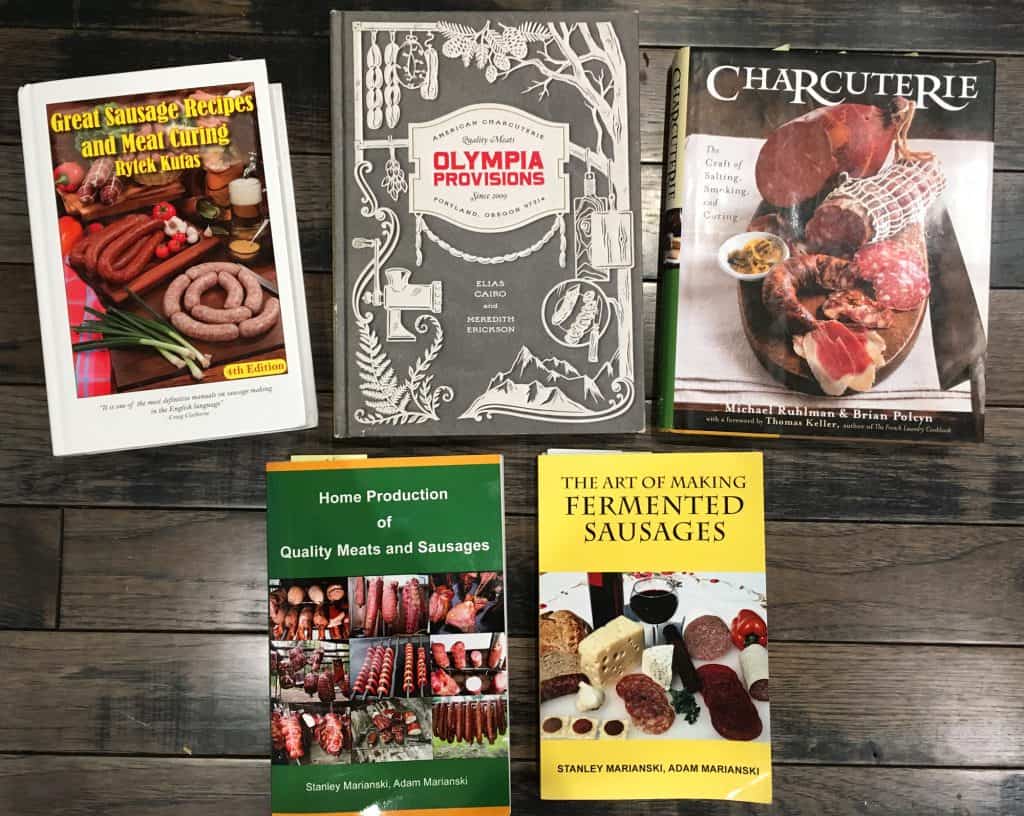
German Bratwurst Recipe
Then let’s get started!
Dice the pork and fat and freeze them for about 45 minutes to get them to a temperature of 32 degrees F (0 celsius).
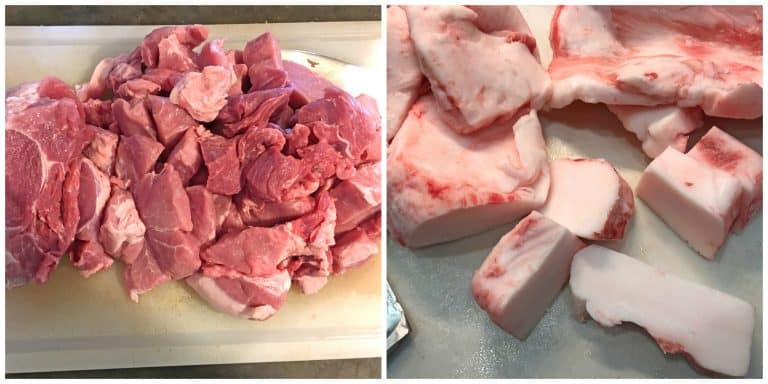
Combine the pork, fat and crushed ice in a bowl and then, working quickly, grind the mixture through a 1/4 inch (6mm) die. Preferably grind the meat mixture into a bowl set atop an ice bath to keep the meat cold. Grind half of the ground mixture a second time. It is imperative that the meat be at a constant cold temperature so that the fat doesn’t get too soft. You should be able to see clear definition between the lean meat the specks of fat in the ground mixture.
Chill the meat in the refrigerator while you assemble the spice mixture.
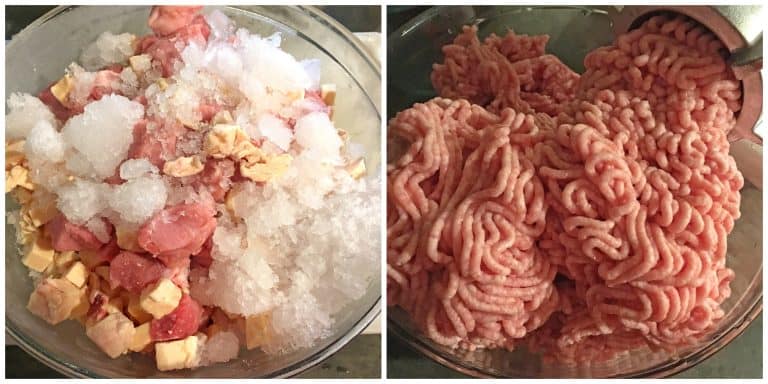
In a small bowl combine all the spices.
Remove the ground meat from the fridge and place it on the stand mixer fitted with a paddle attachment. Add the spice mix and dry milk powder.
Mix the meat mixture with the paddle for 3-4 minutes until threads begin to appear in the meat: If you take a clump of meat and pull it apart with your fingers you will see tiny threads pulling apart. When you see this your meat is ready. If the meat mixture is too dry and stiff, add a little ice water. **If the meat mixture is too dry and stiff, add a little
ice water. You want a soft/smooth mixture that will easily go into the casings.
*This is also the time to taste your sausage mixture so you can adjust the seasonings if needed. To do this, take a bit of the meat mixture, fry it up in a pan, taste it and adjust the seasonings if needed.
Place the meat mixture back in the refrigerator while you prepare the casings.
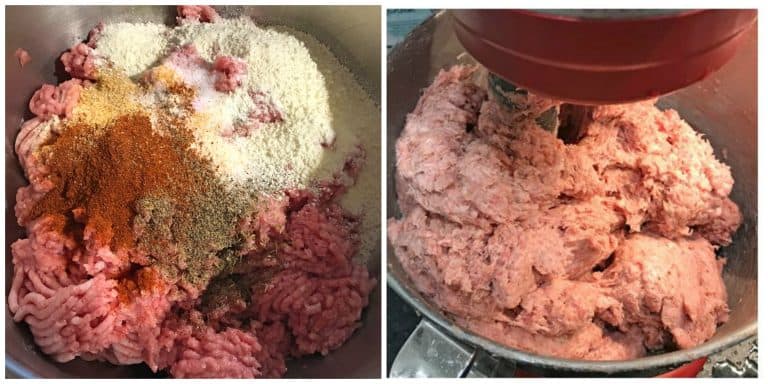
Thread the sausage stuffer with the prepared hog casings, fill the sausage stuffer with the meat mixture, and stuff the casings being careful to avoid air gaps while also being careful to not over-stuff the casings.
Twist the sausages into links. Use a sausage pricker to prick any air bubbles out of the links.
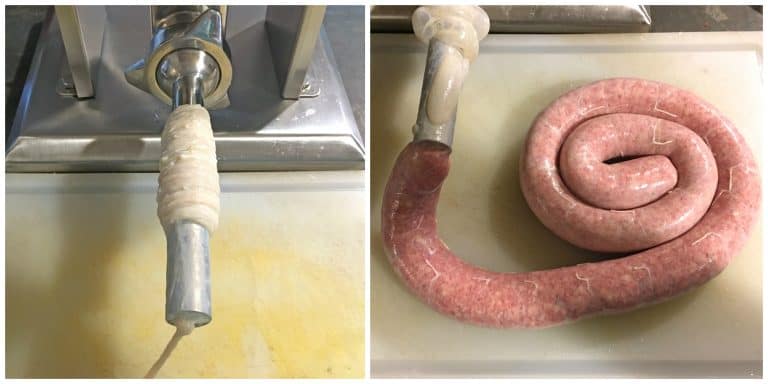
Your Bratwursts are finished. For best results chill the sausages overnight.
To prepare them, you can gently poach them in lightly salted water (optional to ensure they’re evenly cooked or you can poach them in beer to infuse them with more flavor) and then fry or grill them to get their skins nice and crispy. Once poached they will keep in the fridge, tightly wrapped, for up to a week.
You can either freeze the Bratwursts raw prior to poaching (then thaw, poach, fry/grill) or freeze them once they’re poached.
Whether pan-fried or grilled, you’re going to love these Bratwursts!
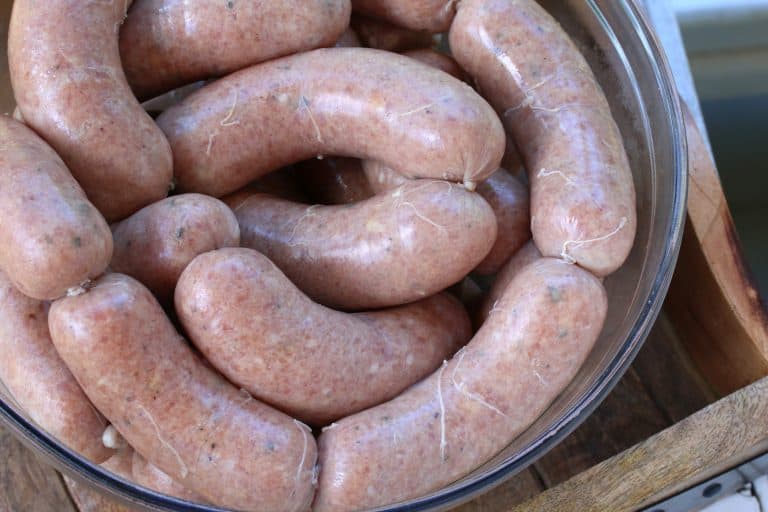
What Do You Serve with Bratwurst?
The most popular accompaniments include a crusty roll cut open and slathered with German mustard or served with sauerkraut, French fries, or potato salad like my authentic German Potato Salad. See my Oven Baked French Fries and Baked Potato Wedges.
The Bratwurst is also popularly transformed into the famous Currywurst by slicing the sausages and serving it topped with Curry Ketchup (see our recipe for Currywurst).

For more homemade charcuterie recipes try my:
- Homemade Bacon
- Porchetta
- Gravlax
- Canadian Bacon
- Italian Sausage Recipe
- Mexican Chorizo
- Capicola
- British Bangers
- Breakfast Sausage Recipe
- Pork Rillettes
- Smoked Ham Hocks
- Smoked Ham
- Smoked Cheddar Sausages
Save This Recipe
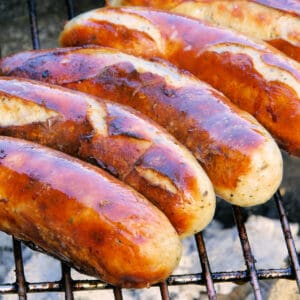
Homemade German Bratwurst
Ingredients
- 2 1/2 pounds boneless pork shoulder (can substitute part veal if desired) , cut into 1/2 inch pieces and put in freezer for 45 minutes prior to grinding
- 12 ounces pork back fat , cut into 1/2 inch chunks and put in freezer for 45 minutes prior to grinding
- 2 cups crushed ice
- For the Spice Mixture:
- 1 1/2 tablespoons salt
- 1/4 cup dried milk powder
- 1 1/2 teaspoons freshly ground white pepper
- 3/4 teaspoon freshly ground black pepper
- 1 teaspoon ground mace (can substitute nutmeg but strongly recommend mace for traditional German flavor)
- 1 teaspoon ground ginger
- 1 teaspoon dried marjoram
- 3/4 teaspoon mustard powder
- 1/4 teaspoon ground cardamom
- 1/4 teaspoon ground coriander
- 1/4 teaspoon crushed caraway seeds
- 32mm natural hog casing , about 4 feet
Instructions
- Combine the pork, fat and crushed ice in a bowl and then, working quickly, use a meat grinder to grind the mixture through a 1/4 inch (6mm) die. Preferably grind the meat mixture into a bowl set atop an ice bath to keep the meat cold. Grind half of the ground mixture a second time. Note: It is imperative that the meat be at a constant cold temperature so that the fat doesn't get too soft. You should be able to see clear definition between the lean meat the specks of fat in the ground mixture.Chill the meat in the refrigerator while you assemble the spice mixture.
- In a small bowl combine all the spices.Remove the ground meat from the fridge and place it on the stand mixer
fitted with a paddle attachment. Add the spice mix and dry milk powder.Mix the meat mixture with the paddle for 3-4 minutes until threads begin to
appear in the meat: If you take a clump of meat and pull it apart with your
fingers you will see tiny threads pulling apart. When you see this your
meat is ready. *If the meat mixture is too dry and stiff, add a little
ice water. You want a soft/smooth mixture that will easily go into the casings.*This is also the time to taste your sausage mixture so you can adjust the
seasonings if needed. To do this, take a bit of the meat mixture, fry it
up in a pan, taste it and adjust the seasonings if needed.Place the meat mixture back in the refrigerator while you prepare the
casings. - Thread your sausage stuffer with the prepared hog casings, fill the sausage stuffer with the meat mixture, and stuff the casings being careful to avoid air gaps while also being careful to not over-stuff the casings.Twist the sausages into links. Use a sausage pricker to prick any air bubbles out of the links.For best results chill the sausages overnight.
- To prepare the bratwursts, you can gently poach them in lightly salted water (place sausages in pot of water, gradually bring liquid to a light simmer/do NOT boil, and poach sausages until partially cooked, 3-4 minutes) and then fry or grill them. Poaching is optional if you want to ensure they're evenly cooked in the middle or if you want to infuse them with more flavor, such as poaching them in beer. Once poached they will keep in the fridge, tightly wrapped, for up to a week.You can either freeze the Bratwursts raw prior to poaching (then thaw, poach, fry/grill) or freeze them once they're poached.This yields roughly 10 bratwursts depending on the size and diameter.
Nutrition
Originally published on The Daring Gourmet July 9, 2019



















Made 4 20-pound batches using this recipe today. Excellent! We did add jalapeños to 3 batches and cheddar to one and pepper jack cheese to one. All were really good. Thanks!
Whoa, that is FANTASTIC, Christina!! I’m blown away – 80 pounds?? WOW, I envy your stamina! I’m so glad you enjoyed them and congrats on that treasure trove of brats you’ve made!
This is simply a fantastic recipe. The author’s details and notes were perfect for a rookie sausage maker. Both batches came out great and are simply fantastic. We did prefer the mace to the nutmeg (didn’t have mace first batch) and we’re dairy free. Very well done and many thanks for sharing.
I’m so glad you enjoyed them, Mike, thanks for the feedback!
Sehr geehrte Kimberly,
I am looking forward to making this bratwurst recipe posted. Thank you for sharing. My family origins are from the Swabian area of Germany, Sulz am Neckar. I read here-in your comment about the Rote Wurst from that region and would be interested in the/a recipe to make same. Thank you in advance for information on that.
Mit Freundlichnen Gruess, Al
Hi Albert, thanks for your comment. I haven’t developed a recipe for Rote Wurst yet but whenever I get around to it I will definitely post it. I hope you enjoy the Bratwurst!
Just wanted to throw in another vote for a rote wurst recipe! I lived in Stuttgart as a kid and that was my favorite! I’ve searched German deli’s in the states but can’t find it anywhere!
When I was a girl we made homemade sausages and used lamb casings instead of pork casings. My father would order them from the same meat processor where he took our livestock to be butchered.
Turned out fantastic! We loved them. Thanks for the great sausage recipes, your cheddar brats recipe is fantastic too! Along with the canned relish.
That’s wonderful, Jim, I’m so glad you enjoyed all of them, thank you!
Absolutely excellent recipe. The techniques were easy to follow and produced a spot-on brat. I simply used an un-trimmed, 11lb pork butt, but added no additional fat. I then followed the rest of the recipe to the letter, adjusting the seasonings for the volume of meat. Worked great. Not adding extra fat made them a bit leaner. I don’t poach my brats first, so when I cook them, I have to grill them on a bit lower heat, so they’ll cook thoroughly without burning (because they lack the extra fat) but they are amazing. Thanks for sharing this recipe!
That’s wonderful, John, I’m so glad you enjoyed them, thanks so much for the feedback!
where do you buy pork fat back?
Hi Shirley, your local butcher will have it.
Recipe sounds great.
Can you make without the milk powder? I have a dairy allergy.
Yes, you can omit it.